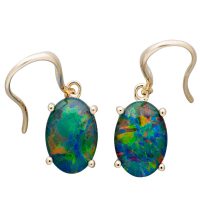Opal is one of the most beautiful and precious gemstones in the world and Australia is famed for this magnificent stone.
The truly unique thing about opal is that it can display all the colours of the spectrum - a result from the interference and diffraction of light passing through the minutely and closely packed silica spheres that make up the opal. The diameter and spacing of these spheres control the colours that we see. Small spheres produce blue colour and larger ones produce reds. Precious opal can display a huge range of colours from clear to white, grey, orange, yellow, pink, red, blue, browns and/or black.

HOW OPAL IS FORMED
Opal is a gem quality form of silicon dioxide and water. Millions of years ago, water seeped into fissures and cracks in surrounding sedimentary and volcanic areas in inland Australia, picking up tiny particles of silica and, eventually over millions of years, hardening into opal. (This is a very simplified version of the process.)
TYPES OF OPAL
SOLIDBlack - opal with a dark or black base or body in colour, enhancing the brilliance of the colours. Mined in New South Wales at Lightning Ridge.
Crystal - transparent or very translucent base or body colour. They can display almost no colour but the belter quality stones show a distinct and bright display of colour. Mined in South Australia at Mintabie, Coober Pedy and Andamooka.
BOULDER OPAL - Consists of opal occurring naturally in the host rock, ironstone. Some ironstone may be visible in the surface of the boulder opal or it may be 'clean faced' - no visible ironstone on the surface. Mined in Central Queensland.